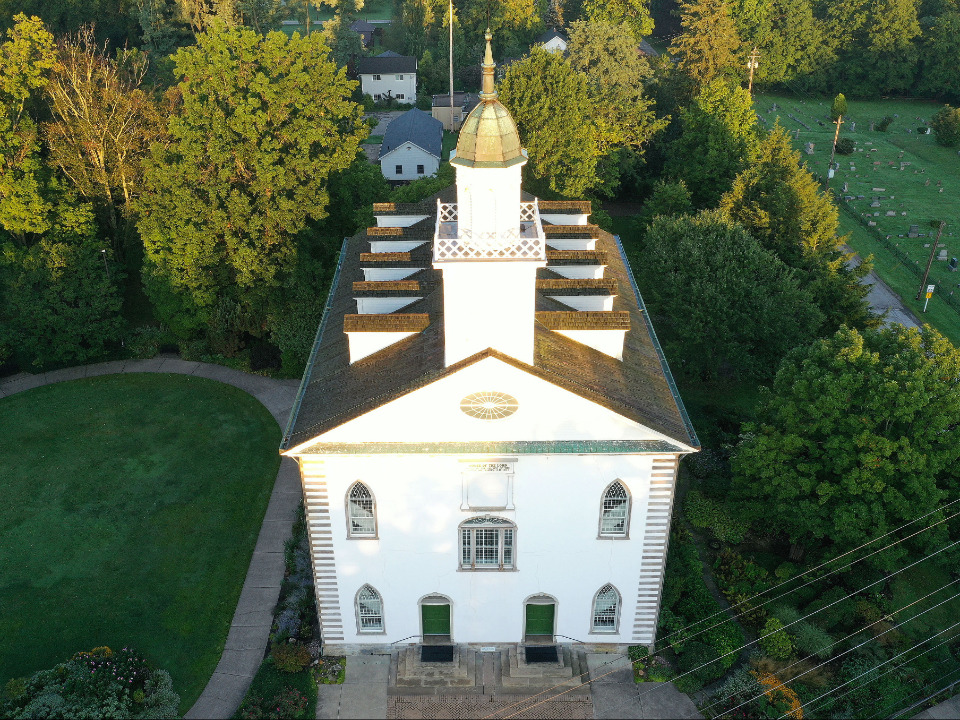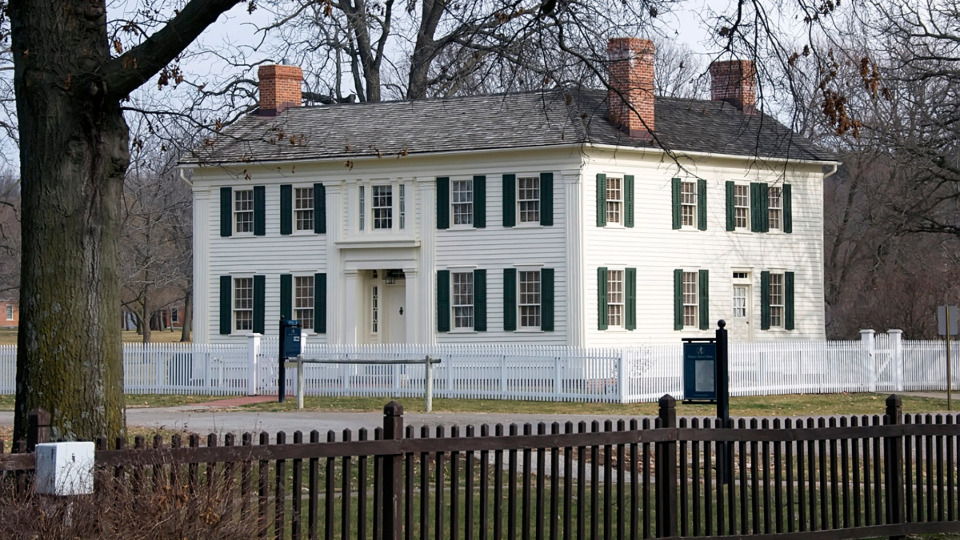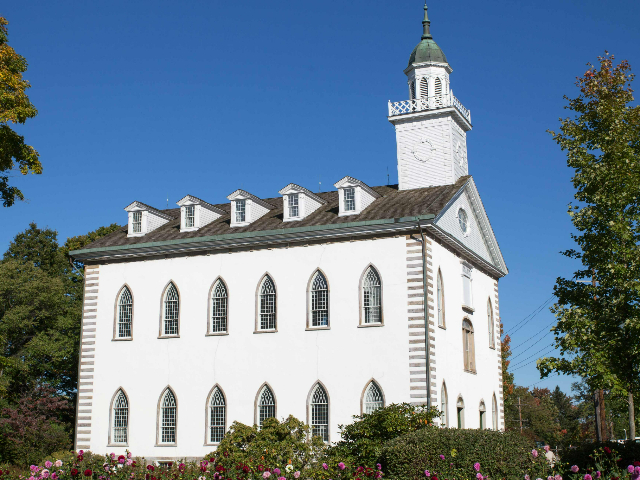
This story appears here courtesy of TheChurchNews.com. It is not for use by other media.
By Kaitlyn Bancroft, Church News
As Latter-day Saints express joy and gratitude over the Church’s recent purchase of the Kirtland Temple in Ohio, some might be wondering when they can next visit this historic site, along with the Nauvoo, Illinois, sites included in the transaction.
Elder Kyle S. McKay, General Authority Seventy, has good news for them.
The Kirtland Temple, along with historic sites in Nauvoo, Illinois, will reopen to visitors on March 25, he said. On the same day in Salt Lake City, the Church History Museum will open an exhibit featuring artifacts such as the Liberty Jail door and portraits of Joseph and Emma Smith.
Elder McKay, who is the Church historian and recorder, said the artifacts arrived in Salt Lake City on Wednesday, March 6, around 5 p.m.
Other artifacts, such as Emma Smith’s walking stick and Lucy Mack Smith’s rocking chair, will stay in Kirtland and Nauvoo, where they are most useful in interpreting the sites they belong to, said Matt Grow, managing director of the Church History Department.
Grow and Elder McKay recently sat down with Church News to discuss the historical and spiritual significance of the Kirtland Temple and the Nauvoo sites.
The acquisition announcement came days after a never-before-seen video presentation featuring the late President M. Russell Ballard of the Quorum of the Twelve Apostles was shown at RootsTech 2024. The film was recorded at various Church history sites, including Kirtland and Nauvoo, prior to President Ballard’s death on November 12, 2023.
Speaking with Church News, Elder McKay also noted that the Kirtland Temple will reopen two days before the anniversary of its dedication: March 27, 1836.
“We feel that we are prepared now for this time and for this responsibility and stewardship,” he said. “It all seemed to gather together and come forth in what looks like an orchestrated manner. But we just did our part and are happy to be … in this position.”

A Landmark Agreement
Latter-day Saint and Community of Christ leaders announced the sale on Tuesday, March 5, in a joint statement. In addition to the Kirtland Temple, the landmark agreement includes the Smith Family Homestead, the Mansion House, the Nauvoo House and the Red Brick Store, all in Nauvoo.
Significant documents and artifacts were also included in the transaction, among them the Bible used in the Joseph Smith Translation of the Bible, seven letters from Joseph Smith to his wife Emma and the cornerstone of the Nauvoo House.
Elder McKay said the acquisition was possible because of a “wonderful, respectful” relationship with Community of Christ.
The two faiths connected through a mutual love for their shared heritage, he said.
Grow said the Church is “deeply grateful” to Community of Christ for the decades of care its members gave the Kirtland Temple, Nauvoo historical sites and various artifacts.
“It’s a sacred trust that they have had … and we deeply feel the sacred trust that we will have, going forward, to continue that legacy of preservation and access to those sites,” he said.
He added that while the Kirtland Temple is not currently slated for any long-term renovations, it’s undergoing analysis to determine what it needs “to continue to stand as a witness.” Latter-day Saints can expect historians to treat the other sites with the same “prudence and patience.”
“Our immediate task has just been to write new tours and to begin the analysis. … We’re not going to rush into anything,” Grow said.

The ‘Humble Kirtland Temple’
The Kirtland Temple is the first temple built in this dispensation and was dedicated almost two centuries ago when Joseph Smith and other early Latter-day Saints lived in Kirtland.
A variety of significant events occurred in Kirtland, Church News reported. For instance, the Doctrine and Covenants records that Jesus Christ “appeared in glory” in the temple, accepting the edifice as His house. Ancient prophets Moses, Elias and Elijah also appeared to Joseph Smith and Oliver Cowdery in the temple (see Doctrine and Covenants 110).
Additionally, during the Kirtland period of Church history, the Lord revealed to His covenant people the priesthood organization of His Church. In the city, the Church first ordained high priests, organized a stake of Zion, called the Seventy, established the Quorum of the Twelve Apostles and created the Council of the First Presidency. Emma Smith completed her work on the first Latter-day Saint hymnal. Joseph Smith oversaw printing of the first edition of the Doctrine and Covenants and the second edition of the Book of Mormon, and translated a portion of the Book of Abraham. Early Church members carried missionary work to the Eastern States, Canada and the British Isles. And members of Zion’s Camp marched from Kirtland to Missouri and back.
The Saints also endured great persecution in Kirtland. Joseph Smith, who lived in Kirtland for seven years, spent more time in that area than any other place as an adult.
Elder McKay referred to Doctrine and Covenants 29:7-8, in which the Lord commanded that his people gather in one place. Kirtland was eventually identified as the right gathering place for that time, Elder McKay said.
Later, when persecution pushed the young Church to Nauvoo and then westward, Elder McKay said external forces didn’t drive the Saints out as much as internal forces drove them together.
“Now to be able to go back to all of these places, and to feel a connection with and learn about what happened there, including the expulsions, creates a greater significance in our lives and helps to tie us to our past,” he said.
Regarding the temple itself, Elder McKay said he can’t help but compare the Kirtland Temple with King Solomon’s extravagant, opulent temple, or the Nephite temple described in scripture as “exceedingly fine” (2 Nephi 5:16).
The “humble Kirtland temple,” however, was built in the Saint’s poverty, evident in the broken china used to create its exterior surface.
But “the thing that’s impressive is the Lord accepted the Kirtland Temple, just the same way He did Solomon’s temple,” Elder McKay said, “and He promised to abide there and be with His people.”
Grow said the Kirtland Temple was “foundational” to the young Church in Kirtland. The Saints poured so many of their resources, temporal and spiritual, into building it, believing in the promise that they would be “endowed with power” there.
“And that’s what happened with the miraculous events of that dedication and then the week after .… They [felt] endowed with power to take the gospel to the world,” Grow said.

‘Hear Again Their Witness’
Among the Nauvoo historic sites, the history is often more domestic than spiritual. For instance, the Smith Family Homestead is where Joseph and Emma lived with their family for four years, and the Mansion House is where Joseph and Hyrum Smith’s bodies lay in state after their martyrdoms.
But that kind of history is no less important to Latter-day Saints than accounts of significant spiritual revelations. Grow said that while places like the Kirtland Temple represent where the Prophet received gospel revelation, many of the Nauvoo sites represent where that gospel was lived.
“Our historic sites … celebrate how Latter-day Saints have lived through time, but they also celebrate those moments when heaven and earth came together in really spectacular ways,” he said.
And when it comes to the documents and artifacts, Grow said the significance of owning them is less about the items themselves and more about how they strengthen individual testimonies.
He recalled how, when the Joseph Smith Papers project concluded in June 2023, it came to him with “incredible clarity” what Joseph Smith would want modern Latter-day Saints to learn from the compilation of letters, journals and other writings. “He would want us to hear his testimony of Jesus Christ, his testimony of the Restoration, his testimony of the Book of Mormon,” Grow said. “All of the manuscripts we have, for historians, are really exciting. … [But] the core purpose, I think, that Joseph and Emma and the early Saints would want us to use these things for is to hear again their witness of Jesus Christ so we can have a witness of Jesus Christ.”

A Blessing to All Latter-day Saints
Grow acknowledged that people sometimes struggle with difficult or painful aspects of Church history. For instance, Kirtland experienced everything from economic uncertainty to violence in the streets.
Individual lives are like that, too, Grow said: filled with periods of peace and spiritual plenty, and other periods of challenge and trial. That’s why history and memories are so important in strengthening people against difficult times.
“If we forget those spiritual experiences, if we forget 1836 and we are only living in 1837, then we are going to have problems,” Grow said.
He also emphasized the importance of keeping a big-picture perspective and not focusing only on challenging aspects of Church history.
“The big picture is that [the Church has] a beautiful history,” Grow said. “It’s a divine history. It’s a history of imperfect people with tremendous faith in Jesus Christ trying to move forward.”
Elder McKay added that while not everyone has ancestors who lived in Kirtland or Nauvoo, every Latter-day Saint has access to vital blessings because of what occurred in those cities. For example, his own ancestors joined the Church in Scotland, but they never would’ve received the gospel if not for what happened in faraway Kirtland, Ohio.
“For me, personally, what happened on April 3, 1836, is most significant because of what happened on June 12, 1984, when … my wife Jennifer and I were sealed — not in the Kirtland Temple, but in the Oakland [California] Temple,” Elder McKay shared.
“I don’t know that I have ancestors in Kirtland. … But I do know that the keys that were restored and the truths that were revealed [there] have a personal and profound impact on me, now and forever.”
Related News
- Read a Timeline of the History of the Church of Jesus Christ in Kirtland, Ohio
- Read a Timeline of the History the Church of Jesus Christ in Nauvoo, Illinois
Copyright 2024 Deseret News Publishing Company.

